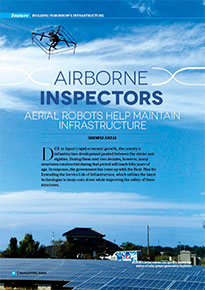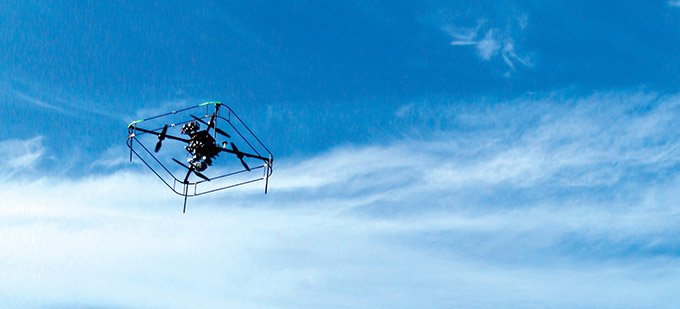Home > Highlighting JAPAN >Highlighting Japan December 2014>Building Tomorrow's Infrastructure
Highlighting JAPAN

Building Tomorrow's Infrastructure
Airborne Inspectors
Aerial robots help maintain infrastructure

Due to Japan’s rapid economic growth, the country’s infrastructure development peaked between the sixties and eighties. During these next two decades, however, many structures constructed during that period will reach fifty years of age. In response, the government has come up with the Basic Plan for Extending the Service Life of Infrastructure, which utilizes the latest technologies to keep costs down while improving the safety of these structures.
A security firm called ALSOK is drawing on its strengths in robotics to help extend the lifespan of buildings and other structures. “As a security provider, we’ve been using robot systems to conduct building maintenance, inspections and supervision,” says Takayoshi Tsuchiya of the R&D Planning Department at ALSOK. “Operation and maintenance of the public infrastructure is an extension of this work, and an area where we could deploy the expertise we have developed thus far.”
The company began with a pilot project using small aerial robots for inspection services at solar power generation facilities. This process is usually quite time-consuming, and requires the use of measuring instruments to check solar panels one by one. By having the aerial robots learn the desired flight routes, they can automatically collect data on potential problems such as abnormal heat. These robots can do their flyovers autonomously or by remote control. When flying autonomously, they maintain an altitude, latitude and longitude inputted in advance via a computer, landing and taking off by themselves. When remotely piloted, the robots can be flown up close to buildings and other structures to take photographs. Self-stabilizing mechanisms keep the robots aloft and make piloting them comparatively easy. Onboard cameras transmit remote video footage that can be checked from the ground. with infrared, optical zooms and other functions can be installed as well.
ALSOK says it plans to use aerial robots to inspect other infrastructure such as bridges, roads and railways. Until now, long-distance aerial vantage points were used to assess bridges, but the Ministry of Land, Infrastructure, Transport and Tourism has taken a “safety-first” approach and decided to inspect all bridges over two meters once every five years using “up-close” vantage points (i.e., within a hand’s breadth), and sent this directive to all of Japan’s municipalities.
Generally, close-up inspections usually involve time-consuming and costly efforts, such as erecting scaffolds or requisitioning a dedicated bridge inspection vehicle. Using a rope to traverse a bridge and take photographs requires a skilled expert, and regional municipalities are hard-pressed to take such measures. This is where ALSOK’s robots can help: piloting them underneath bridges produces images both speedily and safely. During test flights, these machines have been used to identify rust and cracks in steel materials. When refined further, it will become possible to offer high-fidelity image processing that can identify cracks in concrete from photographs. Following an onsite trial this November, the robots are being upgraded, with an eye to deploying them in force within the next three years.
In the future, infrastructure inspection and maintenance robots such as these may very well follow other infrastructural technologies as Japan’s valued exports.
© 2009 Cabinet Office, Government of Japan






